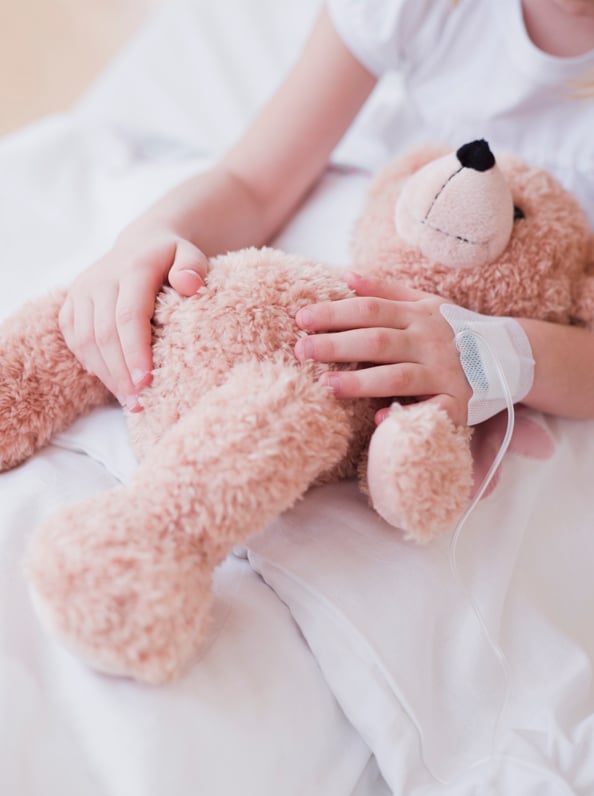We’re well-versed in checking our breasts and booking in that regular smear test, but few of us know much about cancers that affect children. To mark Childhood Cancer Awareness Month this September, our expert shares the need-to-know information that could help protect your child.
1. Childhood cancers are unique
Dr David Pye, Scientific Director at children’s cancer research charity Kidscan explains: “Eight main classes of cancers are normally found in children, with more than 100 types of cancer identified in adults. This suggests that causes of cancer in adults can be more varied.” He adds: “Cancer in both adults and children are caused by genetic mutations in genes. In adults, lifestyle and environmental factors such as UV radiation in sunlight, cigarette smoking and exposure to asbestos are linked to these mutations. It is more difficult to link cancer in children to these environmental factors as they take years to accumulate in adults. Instead the cancer causing mutations in children occur very early in the life of the child, quite often even before birth.”
2. Survival rates are improving
The most common forms of cancer at leukemia (about 35 per cent) followed by brain cancers (about 30 per cent), lymphoma (about 10 per cent), neuroblastoma (about 6 per cent) and Wilms tumour (about 5 per cent). Rhabdomyosarcoma and bone cancers each account for around four per cent of childhood cancers while retinoblastoma accounts for around three per cent of cases. The good news is the survival rates for all are improving. “In the 1960s, the five year survival rate was around 30 per cent and in the 1970s the five year survival rate was just over 50 per cent. Currently, the one-year survival rate is about 90 per cent, the five-year survival rate is around 80 per cent and the ten year survival rate is close to 75 per cent,” says Dr Pye.

3. Treatment can be gruelling
“Whilst the survival rates are very encouraging, it’s important to be aware of the impact that being treated with drugs designed for adults can have on young, growing bodies,” explains Dr Pye. “Current treatments are very harsh and can have devastating long-term side effects, even if they are effective at treating the disease.” He adds, “We need to focus not just on survival, but on ensuring that childhood cancer patients can recover fully and go on to live long and healthy lives.”
4. Early diagnosis is key
Unfortunately, there isn’t a definitive checklist for symptoms of children’s cancer, and most of the symptoms (see box out) are common in children. If in doubt, seek advice from your doctor of medical professional, advises Dr Pye. “Symptoms are the first sign,” he explains. “Of course, early diagnosis is essential for the best prognosis. The challenge with children is balancing the need for early diagnosis with the stress of potentially invasive and frightening tests for no reason.”
Related Story: Angelina Jolie shares her personal story of her battle with ovarian cancer
5. You should keep your child informed
“It is important to identify your child’s illness as cancer and also to name the particular type of cancer,” advises Dr Pye. “It will help build trust and allow the child to feel included in the medical conversations that will inevitably go on around them. Not telling them what is wrong may lead to misunderstandings and cause unnecessary stress, anxiety and fear.”
6. You’ll need a support network
“Parents can begin to adjust to a child’s cancer diagnosis by seeking comfort from themselves, other family members and friends. It may be useful to take notes, record meetings with clinicians or to take other family members and friends into meetings with medical staff,” says Dr Pye. “Guilt, sadness, depression, and anger all follow shortly after diagnosis, it is important for parents to accept that these are normal responses to the situation. They should ask questions about the causes of cancer, talk with parents of other childhood cancer patients, ask for support from other family members or friends and seek professional help from healthcare workers.”
7. We don’t know how to prevent it
“Changes to genes are the primary cause of cancer in children and adults, but despite the wealth of research information available today we still don’t understand the absolute cause of cancer in children,” says Dr Pye. “Overall, the lack of knowledge on the causes of children’s cancer make it difficult to suggests ways in which it may be prevented. In fact, it looks increasingly likely that many children’s cancers are caused by random events, which sometimes occur when a cell divides and not as a result of external events.
Common Cancer Symptoms To Watch Out For
· Unexplained weight loss
· Headaches often with vomiting
· Constant tiredness and paleness
· Persistent pain in bones
· Swelling of joints
· Lump in neck, chest, abdomen, armpits, pelvis
· Excessive bleeding, bruising or rash
· Constant infections
· Eye or vision changes that appear suddenly and persist
· Persistent nausea or vomiting without nausea
If your child has any of the above symptoms take them to your local GP
Download Our Free Healthcare Guide with Over Dhs50,000 Worth of Expert Advice
Words: Aoife Stuart Madge
Image: Corbis











